
Today’s buyer has changed. Buyers seek consumer information when they decide to — taking control of the sales cycle and making buying decisions on their terms. A huge portion of this decision-making happens on the internet, so if buyers can’t find your business there, they may never find you.
Almost every business can benefit from an online strategy — and an obvious piece of this strategy is an effective website. The website becomes your virtual storefront, open 24 hours 7 days a week.
Whether you’re looking to build your first website, or if your existing site just isn’t getting the traffic or leads you were hoping for, you may wonder what it really takes to have a great website. A website needs to not just exist, it needs to perform. It needs to attract visitors, educate them and convince them to buy. But I know what you’re thinking – easier said than done.
What Should a Website Review Checklist Include?
- Search Engine Optimization - This is the process of optimizing your website to get organic traffic. On-page SEO, title and meta tags, 301 redirects, and more will start you on the right path.
- Design - A page's style will include many elements. Top priority is consistency, great custom images, and easy navigation.
- Content - Well-written content is key. Understand your tone, give value, and quality over quantity.
- Conversion - The last step to a great website: conversion. This part will produce results. Use Calls-to-Actions, landing pages, forms, and more.
When reading this list, keep in mind that today, the web is social and interactive. A website can no longer stand-alone or be on its own island. We now need to consider integrating search, design, content, and conversion opportunities with our websites. Gone are the days when all it took was a URL, fancy Flash graphics, and an expensive advertising campaign to boost traffic.
SEARCH ENGINE OPTIMIZATION
When building a website, you may focus on the design and the layout first and pour tons of time and energy into the appearance of it. But answer this: “Does a website do your business any good if no one can find it?” The answer is no. Search engine optimization (SEO) is a crucial part of website strategy. In fact, it is where you should start. When designing a website, each page should have a specific purpose and that purpose should be tied to a single keyword to rank on. It takes hard work and consistency when aiming for the top spot, but these tips will help get you on your way to increasing your organic (non-paid) search engine rankings.
ON-PAGE SEO
This is the portion of SEO that you have the most control over. There are off-page SEO elements that affect your rankings, but your level of control over them is limited. The on-page elements you can control include Headlines, Sub-headlines, Body Content, Keywords, Image Tags, and Links.
Including Keywords in your content helps search engines to find and rank your pages. Pick a primary keyword for each page and focus on optimizing that page for that word. If you oversaturate a page with too many keywords on one page, the page will lose its importance and authority because search engines won’t have a clear idea of what the page is about. In addition, don’t try to keyword stuff your web pages. Having too high a keyword density may have a negative impact on your rankings and can make your pages simply awkward to read. Here are tips to optimize your on-page SEO:
- Place your primary keywords in your headline and sub-headline. These areas of content have greater weight to search engines.
- Include the keywords in the body content, but don’t use them out of context. Make sure they are relevant to the rest of your content.
- Include keywords in the file name of images (e.g. mykeyword.jpg) or use them in the ALT tag.
- Include the keywords in the page URL and keep the URL clean.
- And lastly, write for humans first, search engines second.
TITLE AND META TAGS
A Meta Tag is a line of code that is contained in the background of a web page, or on the page source. Search engines look at meta tags to learn more about what the page is about. Meta tags don’t quite have the level of SEO importance as they used to but are still very important.
If you use Chrome, you can right-click a page and select “View Page Source.” From there, you can check the title and description of the page.
Here is an example of what meta tags look like in an HTML document:
Title – The title of the page seen at the top of a web browser, also the main headline displayed in search engine results.
<title>HubSpot Inbound Marketing Software</title>
Description – A concise description of the page.
<meta name=”Description” content=”Stop pushing. Start attracting. Stop interrupting. Start engaging. HubSpot’s Inbound Marketing Software…”>
If you are using WordPress, I would recommend installing WordPress SEO by Yoast to control the description of your pages as well as other elements of your on-page SEO.
Here’s a look at the SEO Page Analysis of a blog post, with the WordPress SEO by Yoast tool applied:

301 REDIRECT
Occasionally, you may have been perusing a website and clicked a link that led you to a page that may have read “404 Error” or “Page Not Found.” This is a broken link. Typically, this occurs when a page is moved to a new URL and hasn’t been redirected or the page was deleted. When a person or a search engine can’t find a page, it will hurt your SEO authority on that page. In order to solve this problem, you have to ensure you have a 301 redirect in place for all your pages that are throwing a “404 Error.”
I recommend making sure you have access to Google Webmaster Tools to monitor errors as they occur. However, you should take a pre-emptive approach when you can. Some website managers, like HubSpot, will handle 301 redirects for you when URLs are changed.
DESIGN
After you have put effort into making sure your website can be found online, the next part of the website review checklist is to make sure it looks professional and functional.
CONSISTENCY
It’s best practice to not mix up your page styles a great deal from page to page. A page’s style may include elements, such as colors, sizes, layout, and placement. Here are a few key points to maintain consistency.
- Logo placement and size. These details should remain the same across all pages.
- Navigation location and links. It can often be helpful to indicate which link in the navigation is active as well.
- Banner backgrounds. If present on one subpage, this should carry over to other subpages.
- The font. Your font should be the same on every webpage, but it is acceptable to have a different font for headers and body text.
- A consistent footer. The footer should appear across all webpages and provide copyright information.
For layout structure, typically three page layouts exist for most websites: one for the homepage, one for content pages, and one for form pages. For example, your homepage will have a different layout than a landing page for a PPC campaign. Keep the elements in these layouts constant. This will help keep your visitors from feeling lost.
IMAGES
Images can be a powerful tool for a website when used correctly. Don’t use cheesy stock photos. Stock photos from iStock or Fotolia are often a waste, as they offer no added value to a page and easily turn visitors away who have probably seen that same image on other websites.
Marketing Experiments performed a test comparing the use of stock photography versus real imagery on a website and each of their effects on lead generation. What they found was that photos of real people out-performed the stock photos by 95%. Why? Because stock images tend to be irrelevant and impersonal.
Flash animation used to be a popular form of imagery for gaining attention on the web, but it is mainly just a distraction. Furthermore, Flash isn’t completely compatible with mobile devices, which will result in a poor experience for mobile users. If you absolutely must have some animation present on your website, please use HTML5 instead, as it has more browser compatibility compared to Flash.
NAVIGATION
Making a website simple to use and easy to navigate contributes greatly to lead generation. If a user is unable to figure out where they should go to find the information they are looking for, they will likely bounce immediately. Here are some important factors in a site’s navigation:
- Keep the structure of your primary navigation simple (and near the top of your page).
- Include navigation in the footer of your site.
- Use breadcrumbs on every page (except for the homepage) so people are aware of their navigation trail.
- Include a Search box near the top of your site so visitors can search by keywords.
- Don’t offer too many navigation options on a page.
- Don’t dig too deep – in most cases, it’s best to keep your navigation to no more than three levels deep.
- Include links within your page copy and make it clear where those links go to. This is also great for SEO!
- Avoid the use of complicated JavaScript and especially Flash for your navigation. Many mobile phones can’t see Flash (yet), thus they won’t be able to navigate your website. The same applies to web browsers that don’t have an updated version of Flash installed.
Make it easy for visitors to use your site. Don’t require them to have to think about where they need to go and how to get there.
CONTENT
The rise of inbound marketing and content marketing has created the need for excellent content in order to compete on the web. Changes in SEO also make it important to provide valuable content that readers will share. Great content is what search engines and people are looking for. Furthermore, well-written content is used as a persuasive tool to drive traffic into leads, as long as it doesn’t come off as sales-oriented off the bat. Take a look at these must-haves for creating killer website content.
TONE
There are four basic questions you need to ask yourself regarding the content of your website.
- Will people know what I do within seconds?
- Will they understand what page they’re on and what it’s about?
- Will they know what to do next?
- Do they understand why they should buy/subscribe/download from this site instead of another?
The answers to all these questions may all seem blatantly obvious to you, but sometimes they get lost in translation on the web. If a visitor can’t figure it out quickly and the answer is buried in pounds of text, then that’s a no-no. It should be readily apparent in order to help them take the next action you want them to and become a lead. Your goal is to be understood.
VALUE
Your website is for more than just product or service content. Visitors are searching for answers, education, and value. One way you can offer this value is to provide visitors with educational content such as eBooks, whitepapers, videos, blog posts, and other forms of content that will help them along their path in the buyer’s journey. Nurturing prospects into your marketing and sales funnel will help you to sell to leads who are ready to buy and are sales-qualified.
In product-specific content, write as if you are speaking directly to your audience. Use words like “you” and “we.” Don’t be afraid to sound human, people will do business with you because they like who you are and not only what you do.
QUALITY
Creating quality is not easy. Quality content should be unique in that it is hard to find elsewhere, it provides educational value or presents a perspective on a matter that has not yet been covered. Today, search engines are getting smarter and buyers are becoming more selective, meaning that quality content is truly king. This includes:
- Offer unique content. People love this and so do search engines.
- Write for humans, not search engines. People don’t read like robots.
- Provide value and educational content that helps others.
- Do your research when paying for content that is written by third-party services. Some work well, others do not.
- Keep content fresh. Having news that’s two years old still sitting on your homepage will probably give your visitors a bad feeling.
Write your product content as if you are helping them solve their problems.
CONVERSION
The final part of your website review checklist is taking that great design and content and it putting together in a way that will produce results in the form of transforming traffic into leads. Here are some must-haves for increasing your website conversions.
CALLS-TO-ACTION
A Call-to-Action (CTA) is used to help take website visitors down the path you want them to take in order to move them through your marketing funnel. A CTA is typically seen in the form of a button, but here are a few extra tips to help your CTAs pop:
- Make them bigger and bolder than most other elements on the page, but don’t overdo it.
- Consider the colors of the CTA. Whether it is a link, button, or image. Make CTAs look so good people will want to click on them.
- Offer CTAs that provide value, like guides, whitepapers, estimates, etc. “Contact Us” is the worst form of a CTA.
- Don’t rely on CTAs as your only option for conversion.
- Make the CTA look clickable. You can do this by making a button or adding a hover effect to an element.
- Less is more. Keep it simple and clear what is being offered.
- Test when possible. Try testing different colors (e.g. red versus green buttons), language, and placement to see which CTAs get more clicks and drive more leads (learn about A/B testing tools here).
Below is an example of a CTA for a free e-book. Notice that it’s bright, eye-catching, and gets right to the point about the value the user will receive by clicking.

CTAs are the key to lead generation, but they need to be done right to convert traffic into leads.
LANDING PAGES
This is where your CTAs will usually link to along the conversion path. Landing pages are used to “capture” information from a prospect and create a lead. In order to be a landing page, these elements should be present:
- A headline and (optional) sub-headline
- A brief description of the offer/CTA
- At least one supporting image
- (Optional) supporting elements such as testimonials or security badges
- And most importantly, a form to capture information
Landing pages direct your visitors to one particular offer and eliminate the distractions of everything else on your website. The list above gives you the basics of a landing page, but what makes an effective landing page?
- Keep your pages simple and minimize distractions. Include the elements on the previous page and only what is needed.
- Never ever use your homepage as a landing page.
- Remove main site navigation from the landing page so visitors can focus on completing the form and not continue to search your site.
- Make it very clear what the offer is and make it irresistible.
- Absolutely make sure that the content on your landing page matches your call-to-action. If there is a disconnect in your messaging, visitors will hit the Back button.
- Reduce friction – don’t make visitors think too much or do too much work (i.e. reading).
- Use the right form and only collect the information you absolutely need (see the section on Forms below for more details). Effective landing pages are what will turn your website into a lead-generating machine.
FORMS
Forms are often tricky to use effectively because some can have too many fields. In reality, you probably don’t need a lot of information. However, there is no magic answer to the number of fields your form should have.
The fewer fields you have, the more likely a visitor is to convert into a lead on that form. Each form field is viewed as a barrier for the visitor, so at the top of the funnel, less is more. However, further down the sales funnel, a longer form may be required to add more specific fields to weed out prospects and create more sales-qualified leads. Here are a few recommendations for landing page forms:
- Only ask for the information you need for you or your sales team. Also, avoid asking for sensitive information that companies or consumers may not want to disclose.
- Consider the value of the offer. The more valuable an offer may be perceived, the more information you may be able to ask for in return. If it’s a newsletter subscription, only ask for an email address (and maybe first name, at most).
- Reduce anxiety – People are more resistant to giving up their information these days, especially because of the increase in spam. Add a privacy message (or link to your privacy policy) that indicates their email will not be shared or sold.
- Don’t use the word “SUBMIT” on your form buttons! No one wants to submit anything. Instead, try “download whitepaper,” “Get your free eBook,” or “Join our newsletter.”
- If advertising a downloadable offer as your CTA, fulfill the request instantly. For example, if your form is for a whitepaper download, include a link to download that whitepaper on the very next page (typically called a “thank you” page).
CONCLUSION
Follow these guidelines and you will soon have a great website that generates traffic, leads, and sales. However, this is not a one-time website review checklist. Remember, your website should be an active, social, and “living” tool for your business. Use this checklist periodically to ensure success on the web and continued growth.
Curious about inbound for your business? Check us out!



